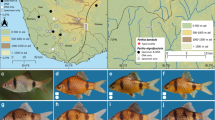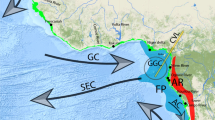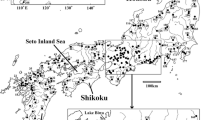Abstract
Parabotia curtus is the only botiid species in Japan, where its range is restricted to two small regions, Kinki and Sanyo. In this study, we performed molecular phylogenetic and population genetic analyses to reconstruct the evolutionary history of this species. A time tree constructed based on mitochondrial genome data revealed that P. curtus was one of the earliest species derived from the most northward range-expanding botiid group (Parabotia) during the Late Miocene. A reduction in its distribution and population size during the Late Pleistocene was inferred from shallow but clear regional population divergence, as verified by mitochondrial sequence and microsatellite data. These results provide evidence that this species is a relict of an old layer of Japanese freshwater ichthyofauna and emphasize the need to conserve the Kinki and Sanyo populations as distinct evolutionary units.






Similar content being viewed by others
References
Abe T, Sakamoto T (2011) Embryonic development and larval behavior of the kissing loach (Parabotia curta): adaptations to an ephemeral, hypoxic environment. Ichthyol Res 58:238–244
Abe T, Kobayashi I, Kon M, Sakamoto T (2007a) Spawning behavior of kissing loach (Leptobotia curta) in temporary waters. Zoolog Sci 24:850–853
Abe T, Kobayashi I, Kon M, Sakamoto T (2007b) Spawning of kissing loach (Leptobotia curta) is limited after the formation of temporary waters. Zoolog Sci 24:922–926
Aitchison JC, Ali JR, Davis AM (2007) When and where did India and Asia collide? J Geophys Res Solid Earth 112:B05423
Aoyama S, Watanabe S, Ishikawa S, Nishida M, Tsukamoto K (2000) Are morphological characters distinctive enough to discriminate between two species of freshwater eels, Anguilla celebesensis and A. interioris? Ichthyol Res 47:157–161
Avise JC (2000) Phylogeography: the history and formation of species. Harvard University Press, Cambridge
Avise JC (2004) Molecular markers, natural history and evolution (2nd edn). Sinauer Associates, Sunderland
Avise JC, Arnold J, Ball RM Jr, Bermingham E, Lamb T, Neigel JE, Reeb CA, Saunders NC (1987) Interspecific phylogeography: the mitochondrial DNA bridge between population genetics and systematics. Annu Rev Ecol Syst 18:489–522
Avise JC, Bowen BW, Ayala FJ (2016) In the light of evolution X: comparative phylogeography. PNAS 113:7957–7961
Brown KH (2008) Fish mitochondrial genomics: sequence, inheritance and functional variation. J Fish Biol 72:355–374
Burridge CP, Craw D, Fletcher D, Waters JM (2008) Geological dates and molecular rates: fish DNA sheds light on time dependency. Mol Biol Evol 25:624–633
Clement M, Snell Q, Walke P, Posada D, Crandall K (2002) TCS: estimating gene genealogies. Proc 16th Int Parallel Distrib Process Symp 2:184
Clift PD, Hodges KV, Heslop D, Hannigan R, Van Long H, Calves G (2008) Correlation of Himalayan exhumation rates and Asian monsoon intensity. Nat Geosci 1:875–880
Cox CB, Moore PD, Ladle RJ (2016) Biogeography: an ecological and evolutionary approach (9th edn). Wiley, Hoboken
Darriba D, Taboada GL, Doallo R, Posada D (2012) jModelTest 2: more models, new heuristics and parallel computing. Nat Methods 9:772
Drummond AJ, Suchard MA, Xie D, Rambaut A (2012) Bayesian phylogenetics with BEAUti and the BEAST 1.7. Mol Biol Evol 29:1969–1973
Earl DA, vonHoldt BM (2012) STRUCTURE HARVESTER: a website and program for visualizing STRUCTURE output and implementing the Evanno method. Conserv Genet Resour 4:359–361
Edwards SV, Robin VV, Ferrand N, Moritz C (2021) The evolution of comparative phylogeography: putting the geography (and more) into comparative population genomics. Genome Biol Evol 14:evab176
Evanno G, Regnaut S, Goudet J (2005) Detecting the number of clusters of individuals using the software STRUCTURE: a simulation study. Mol Ecol 14:2611–2620
Excoffier L, Lischer HEL (2010) Arlequin suite ver 3.5: a new series of programs to perform population genetics analyses under Linux and Windows. Mol Ecol Resour 10:564–567
Froese R, Pauly D (2021) FishBase. http://www.fishbase.org. Accessed 22 Nov 2021
Goudet J (2003) Fstat (ver. 2.9.4), a program to estimate and test population genetics parameters. http://www.unil.ch/izea/softwares/fstat.html. Accessed 22 Nov 2021
Guindon S, Dufayard JF, Lefort V, Anisimova M, Hordijk W, Gascuel O (2010) New algorithms and methods to estimate maximum-likelihood phylogenies: assessing the performance of PhyML 3.0. Syst Biol 59:307–321
Hughes PD, Gibbard PL, Ehlers J (2013) Timing of glaciation during the last glacial cycle: evaluating the concept of a global ‘Last Glacial Maximum’ (LGM). Earth Sci Rev 125:171–198
Iwasaki W, Fukunaga T, Isagozawa R, Yamada K, Maeda Y, Satoh TP, Sado T, Mabuchi K, Takeshima H, Miya M, Nishida M (2013) MitoFish and MitoAnnotator: a mitochondrial genome database of fish with an accurate and automatic annotation pipeline. Mol Biol Evol 30:2531–2540
Iwata A (2006) Significance of paddy field agriculture for the existence of the kissing loach (Leptobotia curta). Jpn J Conserv Ecol 11:133–141
Iwata A (2015) Parabotia curtus (Temminck & Schlegel, 1846). In: Ministry of the Environment (ed) Threatened wildlife of Japan, Red Data Book 2014: Pisces—brackish and fresh water fishes. Gyosei, Tokyo, pp 50–51
Jang-Liaw NH, Tominaga K, Zhang C, Zhao Y, Nakajima J, Onikura N, Watanabe K (2019) Phylogeography of the Chinese false gudgeon, Abbottina rivularis, in East Asia, with special reference to the origin and artificial disturbance of Japanese populations. Ichthyol Res 66:460–478
Jin JJ, Yu WB, Yang JB, Song Y, dePamphilis CW, Yi TS, Li DZ (2020) GetOrganelle: a fast and versatile toolkit for accurate de novo assembly of organelle genomes. Genome Biol 21:241
Kalyaanamoorthy S, Minh BQ, Wong TKF, von Haeseler A, Jermiin LS (2017) ModelFinder: fast model selection for accurate phylogenetic estimates. Nat Methods 14:587–589
Kano Y, Adnan MS, Grudpan C, Grudpan J, Magtoon W, Musikasinthorn P, Natori Y, Ottomanski S, Praxaysonbath B, Phongsa K, Rangsiruji A, Shibukawa K, Shimatani Y, So N, Suvarnaraksha A, Thach P, Thanh PN, Tran DD, Utsugi K, Yamashita T (2013) An online database on freshwater fish diversity and distribution in Mainland Southeast Asia. Ichthyol Res 60:293–295
Katoh K, Standley DM (2013) MAFFT: multiple sequence alignment software version 7: improvements in performance and usability. Mol Biol Evol 30:772–780
Kitanishi S, Hayakawa A, Takamura K, Nakajima J, Kawaguchi Y, Onikura N, Mukai T (2016) Phylogeography of Opsariichthys platypus in Japan based on mitochondrial DNA sequences. Ichthyol Res 63:506–518
Kumar S, Stecher G, Suleski M, Hedges SB (2017) TimeTree: a resource for timelines, timetrees, and divergence times. Mol Biol Evol 34:1812–1819
Leigh JW, Bryant D (2015) PopART: Full-feature software for haplotype network construction. Methods Ecol Evol 6:1110–1116
MacDonald G (2017) Biogeography: introduction to space, time and life (2nd edn). Wiley, Hoboken
Maddison WP, Maddison DR (2021) Mesquite: a modular system for evolutionary analysis. Version 3.70. http://www.mesquiteproject.org. Accessed 22 Nov 2021
Meirmans PG, Van Tienderen PH (2004) GENOTYPE and GENODIVE: two programs for the analysis of genetic diversity of asexual organisms. Mol Ecol Notes 4:792–794
Minh BQ, Nguyen MAT, von Haeseler A (2013) Ultrafast approximation for phylogenetic bootstrap. Mol Biol Evol 30:1188–1195
Minh BQ, Schmidt HA, Chernomor O, Schrempf D, Woodhams MD, von Haeseler A, Lanfear R (2020) IQ-TREE 2: new models and efficient methods for phylogenetic inference in the genomic era. Mol Biol Evol 37:1530–1534
Motokawa M, Kajihara H (2017) Species diversity of animals in Japan. Springer Japan, Tokyo
Palumbi S, Martin A, Romano S, McMillian WO, Stice L, Grabowski G (1991) The simple fool’s guide to PCR. University of Hawaii, Honolulu
Pritchard JK, Stephens P, Donnelly P (2000) Inference of population structure using multilocus genotype data. Genetics 155:945–959
Rabosky DL, Chang J, Title PO, Cowman PF, Sallan L, Friedman M, Kaschner K, Garilao C, Near TJ, Coll M, Alfaro ME (2018) An inverse latitudinal gradient in speciation rate for marine fishes. Nature 559:392–395
Rambaut A (2020) FigTree, version 1.4.4. http://tree.bio.ed.ac.uk/software/figtree/. Accessed 22 Nov 2021
Rambaut A, Drummond AJ, Xie D, Baele G, Suchard MA (2018) Posterior summarization in Bayesian phylogenetics using Tracer 1.7. Syst Biol 67:901–904
Ritchie AM, Lo N, Ho SH (2017) The impact of the tree prior on molecular dating of data sets containing a mixture of inter-and intraspecies sampling. Syst Biol 66:413–425
Saitoh K, Sado T, Doosey MH, Bart HL Jr, Inoue JG, Nishida M, Mayden RL, Miya M (2011) Evidence from mitochondrial genomics supports the lower Mesozoic of South Asia as the time and place of basal divergence of cypriniform fishes (Actinopterygii: Ostariophysi). Zool J Linn Soc 161:633–662
Satoh TP, Miya M, Mabuchi K, Nishida M (2016) Structure and variation of the mitochondrial genome of fishes. BMC Genomics 17:719
Shen W, Le S, Li Y, Hu F (2016) SeqKit: a cross-platform and ultrafast toolkit for FASTA/Q file manipulation. PLoS ONE 11:e0163962
Šlechtová V, Bohlen J, Freyhof J, Ráb P (2006) Molecular phylogeny of the Southeast Asian freshwater fish family Botiidae (Teleostei: Cobitoidea) and the origin of polyploidy in their evolution. Mol Phylogenet Evol 39:529–541
Šlechtová V, Bohlen J, Tan HH (2007) Families of Cobitoidea (Teleostei; Cypriniformes) as revealed from nuclear genetic data and the position of the mysterious genera Barbucca, Psilorhynchus, Serpenticobitis and Vaillantella. Mol Phylogenet Evol 44:1358–1365
Tabata R, Kakioka R, Tominaga K, Komiya T, Watanabe K (2016) Phylogeny and historical demography of endemic fishes in Lake Biwa: the ancient lake as a promoter of evolution and diversification of freshwater fishes in western Japan. Ecol Evol 6:2601–2623
Tang Q, Xiong B, Yang X, Liu H (2005) Phylogeny of the East Asian botiine loaches (Cypriniformes, Botiidae) inferred from mitochondrial cytochrome b gene sequences. Hydrobiologia 544:249–258
Tao W, Yang L, Mayden RL, He S (2019) Phylogenetic relationships of Cypriniformes and plasticity of pharyngeal teeth in the adaptive radiation of cyprinids. Sci China Life Sci 62:553–565
Tominaga K, Nakajima J, Watanabe K (2016) Cryptic divergence and phylogeography of the pike gudgeon Pseudogobio esocinus (Teleostei: Cyprinidae): a comprehensive case of freshwater phylogeography in Japan. Ichthyol Res 63:79–93
Tominaga K, Nagata N, Kitamura J, Watanabe K, Sota T (2020) Phylogeography of the bitterling Tanakia lanceolata (Teleostei: Cyprinidae) in Japan inferred from mitochondrial cytochrome b gene sequences. Ichthyol Res 67:105–116
Tsubokawa K (1988) Zoogeographical consideration on the freshwater fish fauna of the Okayama Region, Japan. Bull Kurashiki Mus Nat Hist 3:1–30
Watanabe K (2012) Faunal structure of Japanese freshwater fishes and its artificial disturbance. Environ Biol Fishes 94:533–547
Watanabe K (2013) Chapter 1. Origin and diversification of freshwater fishes in Lake Biwa. In: Okuda N, Watanabe K, Fukumori K, Nakano S, Nakazawa T (eds) Biodiversity in aquatic systems and environments: Lake Biwa. Springer, Dordrecht, pp 1–19
Watanabe K, Takahashi H (2010) Tansuigyorui chiri no shizenshi (Natural history of freshwater fish geography). Hokkaido University Press, Sapporo
Watanabe K, Takahashi H, Kitamura A, Yokoyama R, Kitagawa T, Takeshima H, Sato S, Yamamoto S, Takehana Y, Mukai T, Ohara K, Iguchi K (2006) Biogeographical history of Japanese freshwater fishes: phylogeographic approaches and perspectives. Jpn J Ichthyol 53:1–38
Watanabe K, Takeshima H, Iwata A, Abe T, Uehara K, Kakioka R, Kihira D, Nishida M (2008) Isolation and characterisation of 39 microsatellite loci in the endangered Japanese loach Leptobotia curta. Mol Ecol Resour 8:145–148
Watanabe K, Abe T, Iwata A (2009) Phylogenetic position and generic status of the Japanese botiid loach. Ichthyol Res 56:421–425
Watanabe K, Kano Y, Takahashi H, Mukai T, Kakioka R, Tominaga K (2010) GEDIMAP: a database of genetic diversity for Japanese freshwater fishes. Ichthyol Res 57:107–109
Watanabe K, Abe T, Iwata A, Shimizu T, Hosoya K (2015) Parabotia curtus. The IUCN Red List of threatened species 2015: e.T11661A83606443. https://doi.org/10.2305/IUCN.UK.2015-4.RLTS.T11661A83606443.en. Accessed 22 Nov 2021
Watanabe K, Tominaga K, Nakajima J, Kakioka R, Tabata R (2017) Chapter 7. Japanese freshwater fishes: biogeography and cryptic diversity. In: Motokawa M, Kajihara H (eds) Species diversity of animals in Japan, diversity and commonality in animals. Springer, Dordrecht, pp 183–227
Acknowledgments
We deeply thank Masanari Matsuda (Lake Biwa Museum) and Kazuhiko Uehara (Biodiversity Center, Osaka) for providing materials and useful information, and the Kinki Regional Office and the Chugoku–Shikoku Regional Office of the Ministry of the Environment, Japan, Agency for Cultural Affairs, Japan, Kameoka City, Okayama City, Kyoto Prefecture, and Okayama Prefecture for their support and permission. This work was partly supported by the Keidanren Nature Conservation Fund, the Fisheries Agency of Japan, and JSPS KAKENHI (nos. 18570086, 21370035, and 20H030090). This study complies with the current laws of Japan. We declare that we have no conflict of interest.
Author information
Authors and Affiliations
Corresponding author
Additional information
Publisher's Note
Springer Nature remains neutral with regard to jurisdictional claims in published maps and institutional affiliations.
Supplementary Information
Below is the link to the electronic supplementary material.
About this article
Cite this article
Ido, K., Abe, T., Iwata, A. et al. The origin and population divergence of Parabotia curtus (Botiidae: Cypriniformes), a relict loach in Japan. Ichthyol Res 70, 256–267 (2023). https://doi.org/10.1007/s10228-022-00884-z
Received:
Revised:
Accepted:
Published:
Issue Date:
DOI: https://doi.org/10.1007/s10228-022-00884-z




